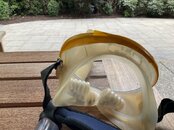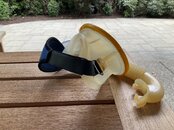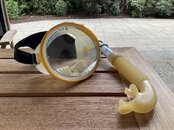This Menorca flex snorkel (Type 1 & 2) is the one I had problems with in rivers in Oregon, and the current would bend the tube under the mouthpiece toward my chin, and cut off air flow.Our second Nemrod snorkel today is the Menorca Flex. Menorca (above) (from Latin: Insula Minor, lit. 'smaller island', later Minorica) is one of the Balearic Islands located in the Mediterranean Sea belonging to Spain. Its name derives from its size, contrasting it with nearby Majorca. Its capital is Mahón, situated on the island's eastern end, although Menorca is not a province and forms a political union with the other islands in the archipelago. Ciutadella and Mahon are the main ports and largest towns. The port of Mahon is the second biggest natural port in the world.
Now for the Menorca Flex snorkel.
Type 1
Type 2
Type 4
The typology comes from Facebook's excellent Nemrod Museum, which does not have an image of type 3 so far ar I am aware. The difference between types and 2 is largely cosmetic, while type 4 has a distinctly different combined mouthpiece and bend. The flexible-hose snorkel's selling point is the ability of the hose and mouthpiece to drop out of the way when it is not in use, a feature appreciated by scuba divers in the early 1970s. Note the presence of a safety band at the top of the last two versions to alert other water users.
Midweek we shall review the Nemrod Vigo and Bagur snorkels. Keep safe and well as winter sets in.
SeaRat






